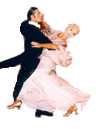 |
ROUND DANCING — CHOREOGRAPHED BALLROOMEDUCATIONAL ARTICLESMAJOR SECTIONS: Figures | Articles | Links | Alph. Index | Search | Home |
|
|
This Business Of Alignmentby Roy & Phyllis Stier It used to be that we were concerned with the four cardinal directions in round dancing — line of dance, reverse line of dance, wall, and center of hall — but evolution has changed all of this long ago. When the Telemarks, Impetus Turns, Spin Turn, etc. came into our lexicon, we discovered that it complicated our alignments considerably. We have even gone so far as to take such figures as the Open Promenade in tango to between wall and diagonal wall — but this is not a concern for most of us at this time. We do need, however, to address the important features of alignment. The Spin Turn, for example, would end facing DRW if taken from the textbooks, but we feel more comfortable with the underturned variety, which ends facing DLW. This is easier to do and gives us more options for a following figure, but it was not originally thus. Earlier in our round dance avocation, we ended the spin to face the wall and then probably used a Back Half Box to still end facing the wall (keeping the cardinal direction intact). Most of our present day Spin Turns end facing DLW (the underturned variety) and then are followed by a Back, Turn, Close or 4, 5, 6 to face DLC. Unfortunately, the old cue "Half Back Box" still persists, even though this would still have us facing DLW. Left Turns used to start facing LOD and make a complete turn in two measures; however, unlike the technique used in Viennese Turns, we had to horse our partners around to make it. We have learned since to start facing DLC and end facing DLW — a much more comfortable situation. The Maneuver is another example of adjustment to alignment. We have learned to start it from DLW and then keep our "track" in this direction without the old-fashioned notion that the man needed to step around the lady to face RLOD. Of course, this meant that we had to use sway to the right in the process, but this is another story.We find that the Open Telemark has three basic ending alignments, depending upon what is to follow, ditto the Whisk. The Double Reverse Spin can vary from 5/8 to full around and start in three different directions. While you are figuring out these permutations, consider the Hover Telemark, which can qualify with as little as a 1/8 turn and go in either direction to boot. This alignment thing probably has some sort of logical conclusion, but we simplify its ramifications by settling on the choreographer anything of a reasonable nature. Since body position and alignment differ in some cases, we should have a look at this. "Alignment" is interpreted as the way the foot is pointing, so that in right and left turns, we don't have a complete match with the body. For example, in the left turn (Reverse Turn in ballroom terminology) the lady points her foot down LOD on step 2 while her body faces DLW. On the other hand, the man points his foot DLW on step 5 while his body faces wall (both on the inside of the turn). In tango, the body is held in such a position that forward steps in closed position for the man curve a little to the left. In semi-closed position ("promenade" in ballroom), the steps are made down LOD with the feet pointing diagonally toward partner. There are more complications, but remember that it is all for the best, so hang in there.
This column comes from a series published in Cue Sheet Magazine between 1987 and 1992, and is reprinted with permission. The full series is collected in an 86-pg booklet, available for $30.00 plus postage. E-mail Fran Kropf at cutecuer@cox.net.
|
 |
|
|
Page last revised